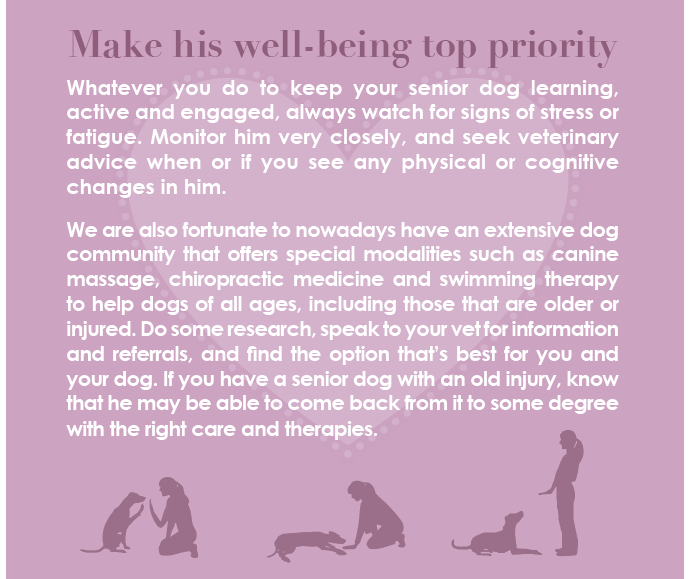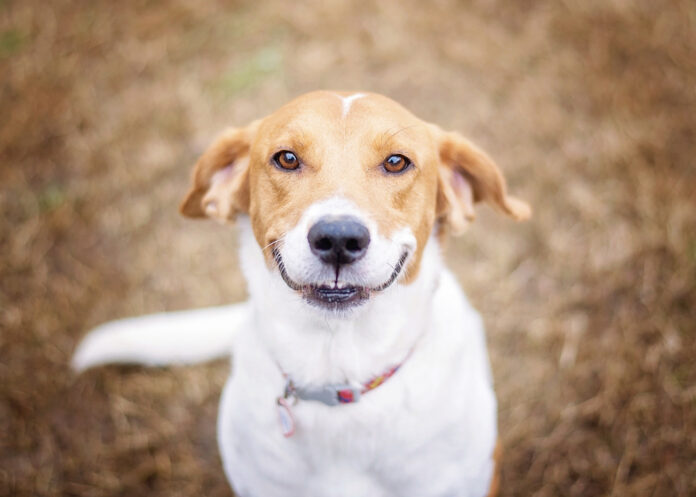Top tips for training senior dogs

“Old dogs can learn new tricks” – and that means training senior dogs can be just as easy as training their younger counterparts.
Many people are choosing to adopt senior dogs to give these old souls a loving and comfortable life during their remaining years. Others are already living with dogs who are entering their golden years. Yet many people believe that training senior dogs is impossible – that once he’s reached a certain age, he can’t learn new things. Nothing could be further from the truth. Older dogs are definitely trainable – you just have to keep his age and abilities in mind. Training is also a great way to keep your elderly friend happy and engaged, while having some fun along the way.
The pros outweigh the cons
Teaching a senior dog as opposed to a puppy does have some challenges, but the pros outweigh the cons. As long as you take your gray-muzzled friend’s physical limitations into account, you’ll be fine. In fact, senior dogs tend to be a bit more stable and focused than younger canines, because they’ve been around the block — and back. They may even be able to teach us a thing or two! Make sure you also have your dog’s hearing and vision checked by your veterinarian; when these senses diminish, it may be necessary to use a leash at all times, for the sake of his safety.
Keep in mind that you also have to take care of your senior dog’s mental health. As we age, our minds can slow down. Our decision-making abilities can falter and the speed at which we comprehend, absorb and store information may change. Hence the familiar term “having a senior moment”. Our dogs are no different. A senior dog may need extra patience during training, as his cognitive abilities and reaction time can be slower than those of a younger dog. But give him time, and he’ll get it. Just keep a watchful eye, and adjust the way you interact with him.
Moving forward
Once you have the go-ahead from your veterinarian, the best way to start with training is to keep including your dog in a activities, even though they may be different from what he enjoyed in the past. The same rationale applies if your senior dog is new to the family. Here are some ideas that will allow you to work on training while exposing your older dog to physical and mental stimulation and fun.
- If your senior is friendly with other dogs, taking a training class together will improve your mutual communication skills. Keep in mind that it doesn’t have to be just about teaching sit/stay/down/come (though this is a great start for any dog), since your senior may know these basics already.
- Training senior dogs to do tricks is fun and often underrated. However, only teach them tricks that their bodies can handle and that they’re capable of doing. Rolling over may be difficult for their joints, but teaching them to “say their prayers” is a showstopper.
- Rally obedience is another way to train your dog that helps keep him active while being less stressful on the body. A training colleague of mine, whose dog is a top agility competitor, has engaged her in rally now that she’s older. As her hearing loss becomes more and more pronounced, rally is a great option because she can work on a leash beside my colleague.
- Scent detection is fairly new and a great sport for dogs of all ages, including seniors. It also involves training as well as physical and mental stimulation. Scent detection is good for older dogs that have always worked, who look forward to working, and don’t want to be put out to pasture. It’s also perfect for dogs that may have failing eyesight or reduced hearing. Using the nose comes naturally to most dogs, and this activity is easy on the body and fun to practice at home.
- If your dog used to do agility, you know this sport involves a lot of training – and it doesn’t have to stop just because your dog is aging. Agility offers veterans’ divisions with modified rules and easier-to-manage equipment.
7 tips for success
- Whatever training activities/sports you do with your senior dog, keep individual sessions short, perhaps five to ten minutes at a time.
- Develop a routine that includes stretching prior to training activities (or any physical exercise). Have him follow a treat as you lure him to the right or left in circles, or stretch his front legs up onto something higher.
- Practice a couple times a day with lots of rest in between. Make sure to avoid too many repetitions. Keep everything positive; find a reward such as a favorite treat or toy, and use that to motivate him. As in all teaching, there is only room for respectful, motivational, reward-based training.
- Show your dog how to do the skills you are teaching him using both verbal and hand signals. Doing this at any age is beneficial, but they can help you communicate more clearly as your dog ages.
- If you have adopted a senior dog, you may find he has some behavioral challenges. He may not like to be around a lot of chaos, or he might feel uncomfortable being approached by other dogs. Rescued and re-homed dogs of any age may need an extra hand to help them navigate the new world they find themselves in. Don’t push your dog into a situation he can’t handle when training or engaging in any activity. Sometimes, seeking the advice of a canine behaviorist is the way to go; he/she will help your dog create positive associations towards things he may have difficulty with.
- If your dog has always been with you, and is now getting older, tailor the activities you enjoy together to take his age into consideration. For example, if catching a disc was his thing when he was young, change it to fetching a low-flying ball instead. Toss the ball close to you, and not too high. This can be as rewarding to him as the great catches of his youth. Make sure the surface you’re playing on is soft and the temperature appropriate for his age and breed.
- If your senior is up to it, a short hike along an interesting trail can be physically and mentally rejuvenating for him. By “interesting”, I mean an area that offers lots of things to stop and sniff at. It will also give you an opportunity to practice training cues such as “come”, “sit” or “stay” with your dog. For more of a challenge, teach him to go around a tree, or stop along the trail to practice some additional obedience skills. Just keep an eye on your dog and turn back when it looks like he’s had enough; remember as well that he may not be able to match your pace, so slow down if you have to. Even for a short hike, bring a pet first aid kit, water bottle, bowl and a few healthy treats.
Senior dogs don’t need to spend their days lying around the house. By keeping on top of your older dog’s existing training skills, or introducing new ones through various activities or appropriate dog sports, you’ll help stay him physical and mentally fit, as well as happy and engaged with you and with life.





